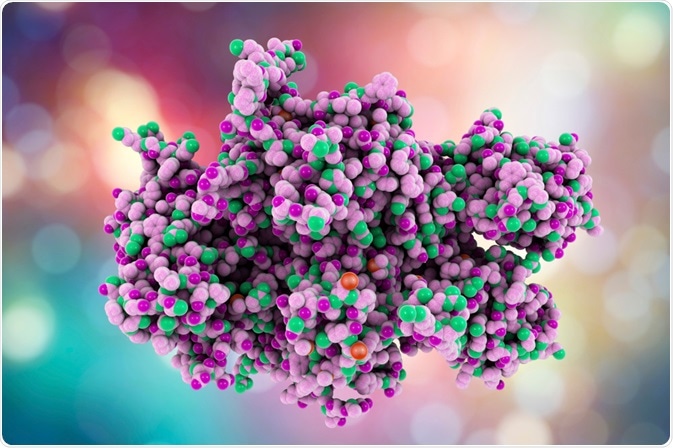Transposons are mobile genetic elements that are capable of self-replicating and inserting themselves into the genome. Whole-genome sequencing has shown that transposons made up 33% of the human genome and are one of the factors leading to dysregulation of diseases such as cancer and neurodegenerative diseases.
What are transposons?
Transposons are interspersed repeats that are capable of copying and inserting themselves into a new location in the genome. The majority of mobile genetic elements in the human genome is made up of retrotransposons, which uses an RNA intermediate and a ‘copy-and-paste’ retrotransposition mechanism.
Retrotransposons originate from retroviruses that are capable of inserting the viral genome into the host genome. Over time, these retroviral genomes have lost functional genes such as viral envelope protein gene env.
As a result, these inserted retroviral genomes can no longer produce viable viruses and became remnants of the retrovirus inserted into the human genome.
In humans, retrotransposons contain genes for reverse transcriptase, which converts the RNA transcribed from DNA retrotransposons into DNA so that the retrotransposon can be integrated into a new location of the genome.
Human retrotransposons are further classified into two groups: long interspersed nuclear elements (LINE) and short interspersed nuclear elements (SINE). LINEs have two open reading frames that encode proteins such as an RNA polymerase that allows transcription of LINE DNA regardless of the location of insertion, and a reverse transcriptase that allows the LINE RNA transcript to be converted into DNA.
They also have an adenosine-rich 5’ region. SINEs are much shorter than LINEs and they have similar genomic structures. However, SINEs are known as parasites of LINEs since SINEs do not encode reverse transcriptase and use that encoded by LINEs.
Regulation of transposons
Given the amount and the ability of retrotransposons to insert themselves into random locations of the genome, retrotransposition can cause instability of the genome and thus has to be regulated.
Silencing mechanisms include epigenetic methylation and RNA interference. Methylation is a reversible process where a methyl group is added to DNA, silencing its transcription.
RNA interference uses non-coding RNA that interacts with retrotransposon transcripts and degrades them and changes transposon histone structure to reduce their transcription.
Role of transposons in disease
Retrotransposon movement can cause diseases by disrupting normal gene functions or a repressor gene that represses the onset of disease; or activating a disease-causing gene; or causing genomic rearrangements by recombining with other retrotransposons.
In patients with hemophilia A, a genetic disease that has a dysfunctional blood clotting factor VIII, it is found that a LINE is inserted into the factor VIII gene and this creates duplications of at least 12 to 13 nucleotides of the factor VIII gene and thus disrupting the function of the gene product.

Image Credit: Kateryna Kon/Shutterstock.com
Similarly, in hemophilia B patients, a disease that involves an abnormality of blood clotting factor IX, retrotransposon insertion into the exon of the gene is shown to cause the gene transcript to be degraded as nonsense messenger RNA.
Transposons are also shown to be associated with the onset of cancer by several mechanisms: by the reactivation of cryptic regulatory elements within transposons that influence oncogene expression, or by disruption of tumor suppressor genes such as DNA repair genes like BRCA2, APC, and RB1.
For example, insertion of a LINE onto APC is shown to be associated with colon cancer. Moreover, methylation loss of a LINE promoter can activate the transcription of an alternative transcript for a truncated and constitutively active MET protein in bladder cancer.
Apart from cancer, transposons also play a role in neurodegenerative diseases. In Drosophila models of Alzheimer’s disease and progressive supranuclear palsy, transcripts of transposons are found.
This suggests that transposon dysregulation is associated with the onset of neurodegenerative diseases. These two neurodegenerative diseases are characterized by deposits of tau proteins in the brain. Pathogenic tau proteins deplete piwiRNAs (piRNA), a group of small, non-coding RNAs that silence transposons transcripts.
As a result, in the presence of pathogenic tau, transposon transcripts are not silenced and can mobilize in neuronal genomes.
Although there is no direct evidence of transposons causing the pathology of neurodegenerative diseases, these dysregulated transposons could potentially insert in regulatory elements or genes contributing to the pathogenesis of neurodegenerative diseases.
Reference:
- Anwar, S. L., Wulaningsih, W., & Lehmann, U. (2017). Transposable Elements in Human Cancer: Causes and Consequences of Deregulation. International journal of molecular sciences, 18(5), 974. https://doi.org/10.3390/ijms18050974
- Kazazian, H., Wong, C., Youssoufian, H. et al. Haemophilia A resulting from de novo insertion of L1 sequences represents a novel mechanism for mutation in man. Nature 332, 164–166 (1988). https://doi.org/10.1038/332164a0
- Nakamura, Y., Murata, M., Takagi, Y. et al. SVA retrotransposition in exon 6 of the coagulation factor IX gene causing severe hemophilia B. Int J Hematol 102, 134–139 (2015). https://doi.org/10.1007/s12185-015-1765-5
- Payer, L.M., Burns, K.H. Transposable elements in human genetic disease. Nat Rev Genet 20, 760–772 (2019). https://doi.org/10.1038/s41576-019-0165-8
- Reilly, M. T., Faulkner, G. J., Dubnau, J., Ponomarev, I., & Gage, F. H. (2013). The role of transposable elements in health and diseases of the central nervous system. The Journal of neuroscience: the official journal of the Society for Neuroscience, 33(45), 17577–17586. https://doi.org/10.1523/JNEUROSCI.3369-13.2013
Further Reading
Last Updated: Jan 28, 2021